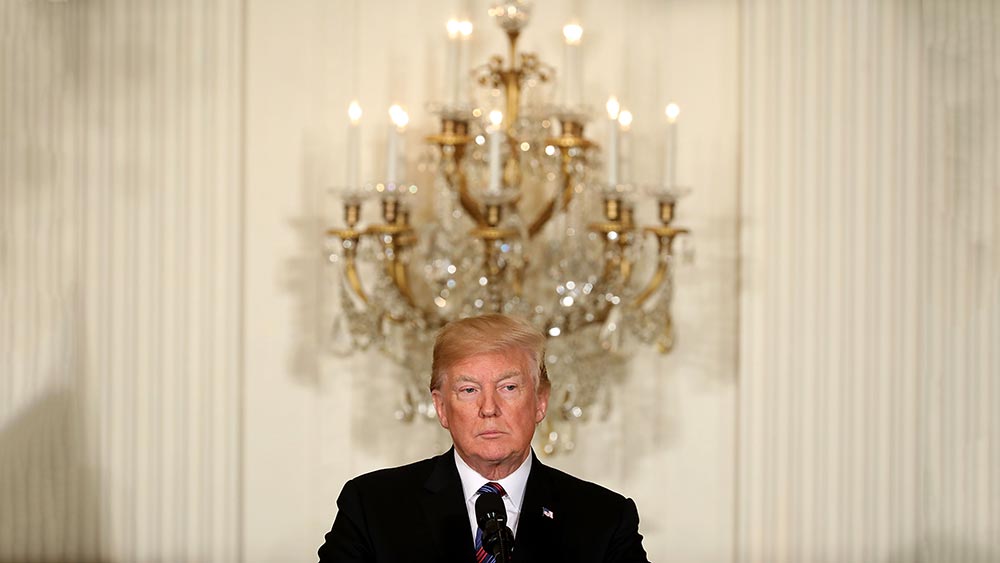Dow plunges more than 550 points as Trump-China trade war threats escalate

President Trump at a news conference in the White House on April 3. Pic: Getty
President Donald Trump has threatened another escalation in a rapidly growing trade battle with China, which then vowed to retaliate.
The developments jolted global markets over the weekend.
The Dow Jones industrial index dropped more than 700 points at one point on Saturday (Australia time).
It ended about 570 points down.
Industrial stocks like Caterpillar and Boeing were among the Dow’s hardest hit, with shares of both companies declining more than 3 per cent.
The White House said in a statement on Friday that Trump was considering new tariffs on $US100 billion worth of annual imports from China.
That follows the Office of the US Trade Representative’s announcement earlier last week of plans for tariffs on $US50 billion in Chinese products.
“In light of China’s unfair retaliation, I have instructed the USTR to consider whether $US100 billion of additional tariffs would be appropriate under section 301 and, if so, to identify the products under which to impose such tariffs,” Trump’s statement said.
Responding on Saturday, China’s ministry of commerce said it would immediately retaliate if the “arrogant” US imposed the sanctions. It said the country would not rule out any options.

Earlier in the week, the US trade representative announced a list of roughly 1300 Chinese goods worth $US50 billion annually that would be subject to new US tariffs, which function as taxes on imports.
The US also previously announced tariffs on Chinese steel and aluminum.
China responded by announcing tariffs on $US50 billion worth of American goods, including soybeans, the largest agricultural export to China from the US.
The tariffs would have consequences for a wide swath of American consumers and businesses.
The USTR has said the measures are retaliation for Chinese intellectual property theft. But they could also have serious consequences for businesses that use the goods from China — as well as consumers who buy those goods.
Larry Kudlow, Trump’s top economic adviser, sought to calm markets Friday afternoon at the White House, to little apparent avail. He said the US was not in a trade war with China.
What is a tariff?
A tariff, in plain terms, is a tax on goods coming into a country.
In the US, many tariffs are paid at the time of entry into the US via a customs broker or agent — along with other duties and fees that may apply to the import.
The idea of a tariff is to push up the price of foreign goods to make the domestic alternative more attractive.
In this case, Trump is attempting to get companies to use fewer Chinese goods and opt for items made in the US or imported from elsewhere.
Hans Mikkelsen, a Bank of America Merrill Lynch strategist, said the new taxes would shift the supply and demand for the various affected goods.
“International Trade 101 analyses the partial equilibrium effects of a tariff as driving a wedge between demand and supply curves, whereby the price goes up and the quantity down,” he said in a note to clients.
What does it mean for businesses?
For many US businesses that use Chinese goods to make their products, the cost to produce their items will increase.
A more direct example comes from Trump’s recent tariffs on steel and aluminum imports.
The Beer Institute — a trade group that represents beer manufacturers — said the 10% aluminum tariff would add $347.7 million in costs for American brewers.
The higher costs could cause businesses to find other areas where they can save money, including in worker pay.
Studies found that a steel tariff imposed by President George W. Bush in 2002 resulted in as many as 200,000 jobs lost in industries that use steel to make their products.
This article first appeared on Business Insider Australia, Australia’s most popular business news website. Read the original article. Follow Business Insider on Facebook or Twitter.
UNLOCK INSIGHTS
Discover the untold stories of emerging ASX stocks.
Daily news and expert analysis, it's free to subscribe.
By proceeding, you confirm you understand that we handle personal information in accordance with our Privacy Policy.








